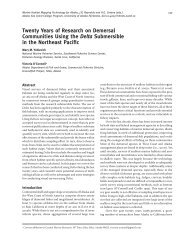724_Final Report.pdf - North Pacific Research Board
724_Final Report.pdf - North Pacific Research Board
724_Final Report.pdf - North Pacific Research Board
You also want an ePaper? Increase the reach of your titles
YUMPU automatically turns print PDFs into web optimized ePapers that Google loves.
were switched to Diet 3 which consisted of 66% silverside and 34% Mazuri for 29 days. <strong>Final</strong> biopsies<br />
were taken on Day 50. A substantial amount of Mazuri was necessary in the experimental diets to<br />
maintain the birds on the minimum amount of required nutrients. Birds were fed in groups by species and,<br />
therefore, individual intakes were not determined. As a result, it is likely that individuals consumed<br />
different proportions of certain diet items to some degree. Krill and silverside were fed in the morning to<br />
ensure that these diet items would be consumed. Krill and silverside were sometimes hand fed to the birds<br />
for training purposes and the remaining allotment placed in feeding bowls accessible to all birds in the<br />
pen. Mazuri was placed in accessible feeding bowls in the afternoon. Daily amounts of each diet item fed<br />
and consumed per flock were recorded. Subsamples of all diet items were collected twice each week<br />
throughout the feeding study, placed in airtight plastic bags, and stored frozen until analysis.<br />
Biopsy sampling<br />
A live biopsy technique according to Iverson et al. (2007) with addition of a local anesthetic was used to<br />
obtain synsacral adipose tissue samples from captive eiders. The bird was held cradled breast down;<br />
feathers were parted with an alcohol sponge, which was also used to disinfect the skin. Feathers were<br />
taped back and 0.1 ml lidocaine was injected subcutaneously. The site was disinfected with a betadine<br />
swab and sprayed with lidocaine spray. A small incision of approximately 1 cm long and lateral to the<br />
midline was made (on the right side for biopsies 1 and 3, left side for biopsy 2). Between 0.02 and 0.15 g<br />
of adipose tissue was excised using forceps and a scalpel blade, and placed in aluminum foil. The site was<br />
closed with Vetbond tissue adhesive (3M, St. Paul, MN, USA) and birds were returned to their pens.<br />
After weighing, samples were placed in chloroform containing 0.01% BHT (an antioxidant) in glass<br />
centrifuge tubes with Teflon-lined caps. Lipid extraction and transesterification was performed the same<br />
day the biopsy was taken.<br />
12



